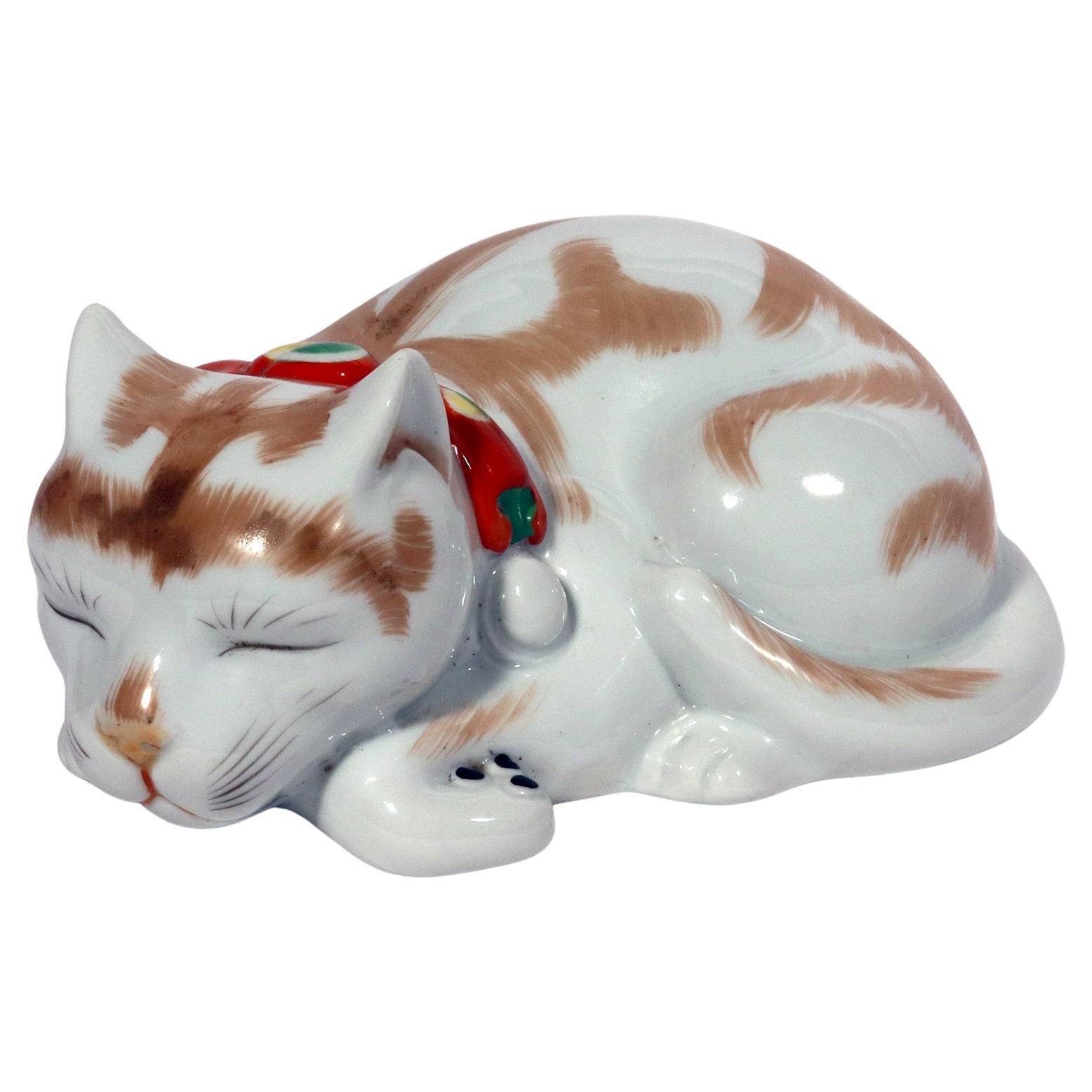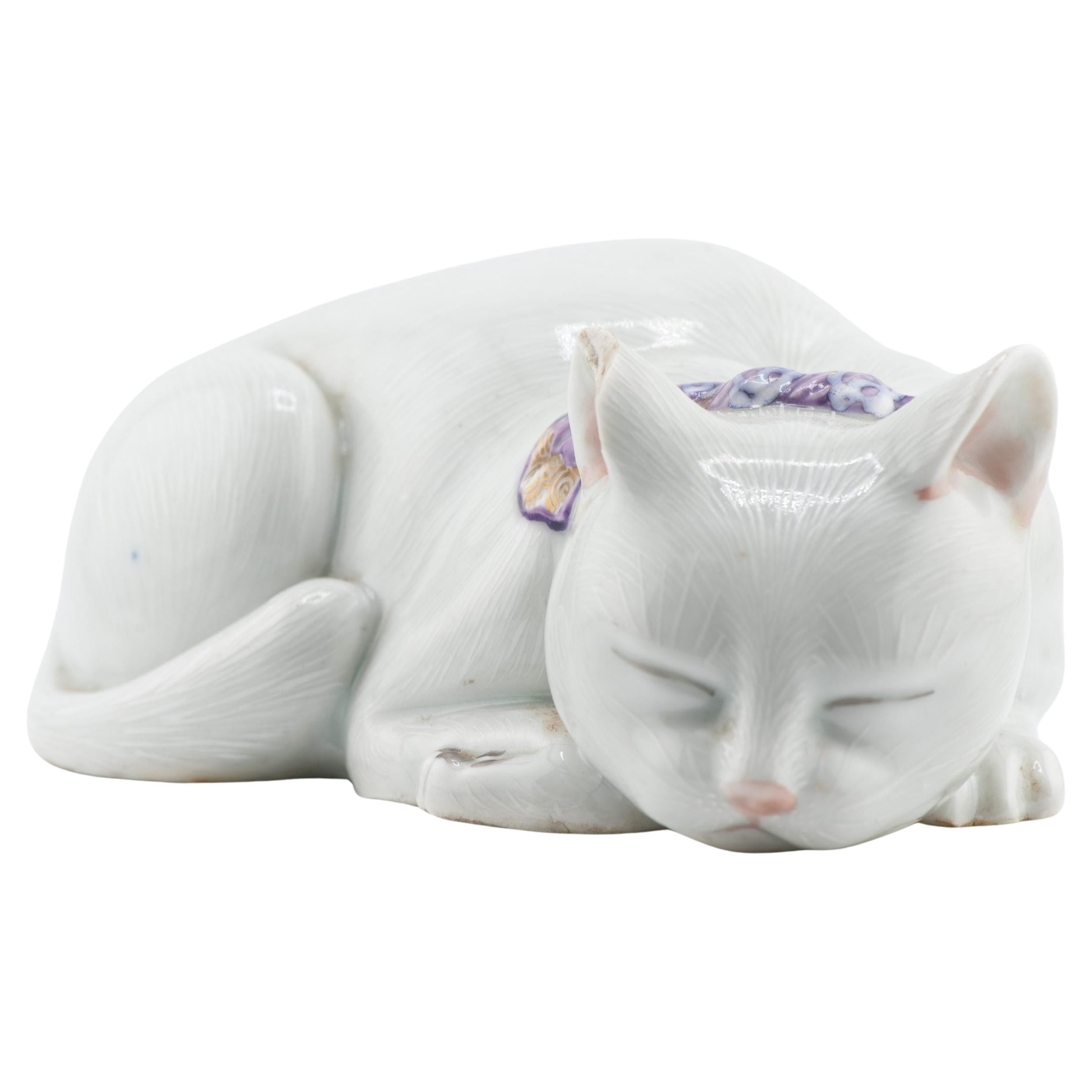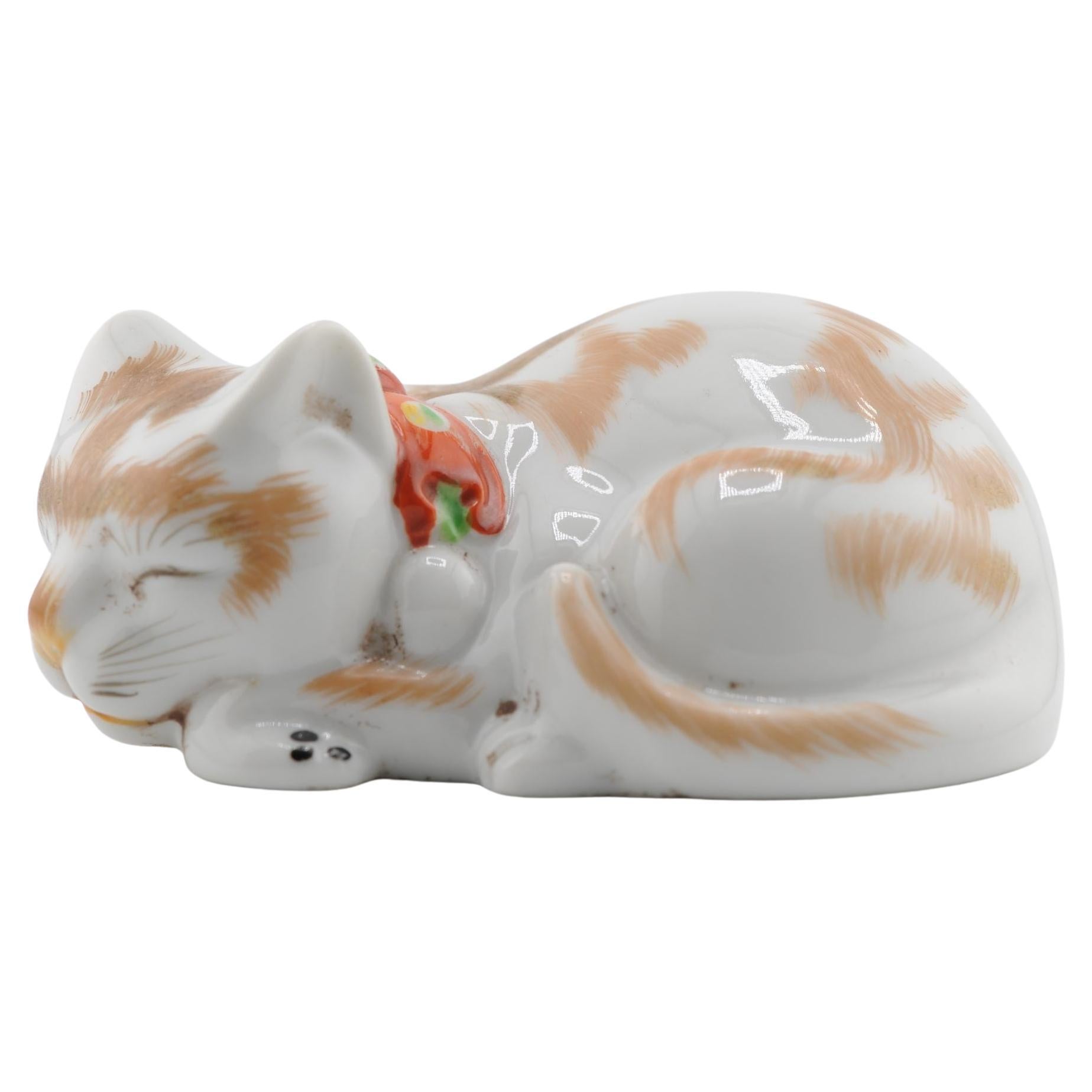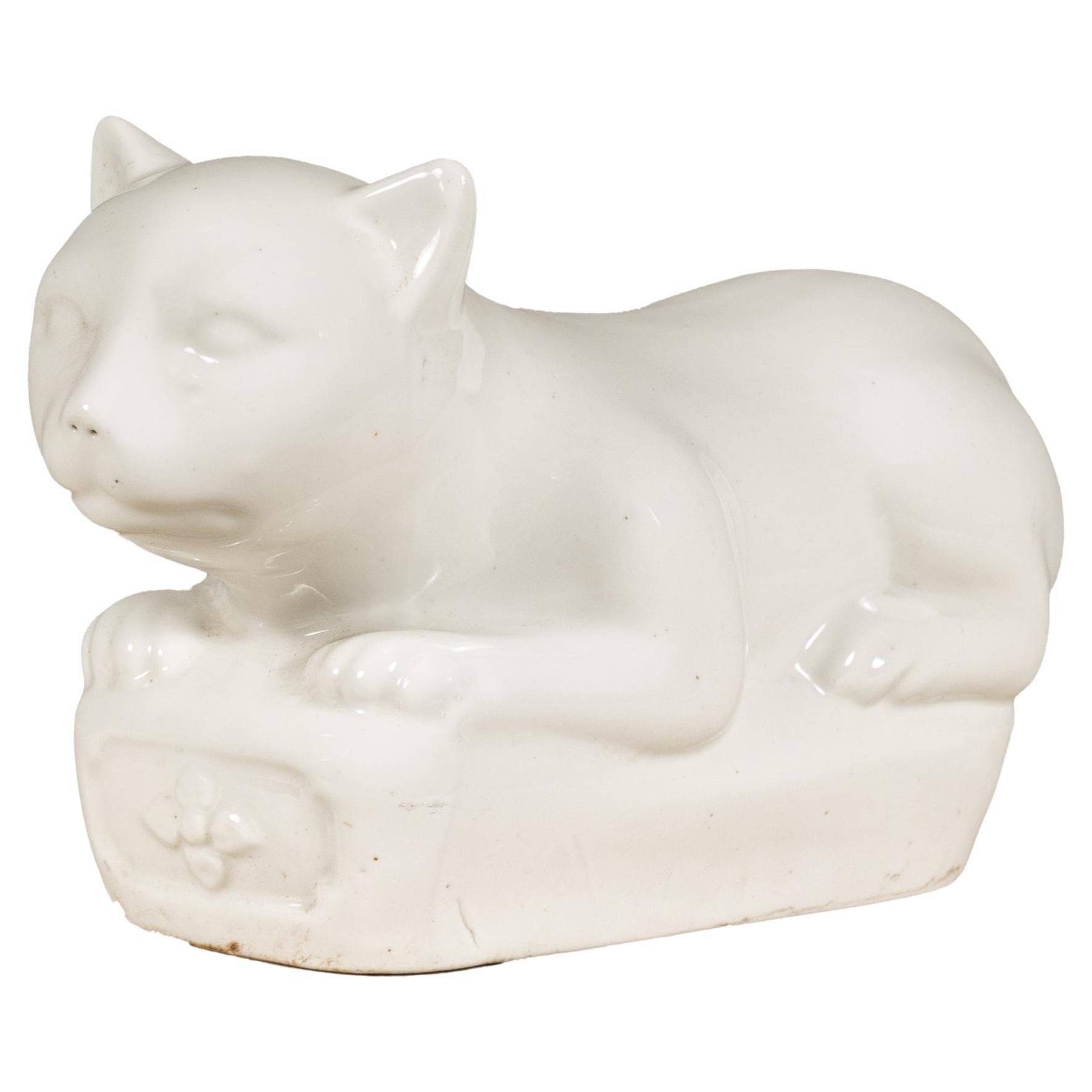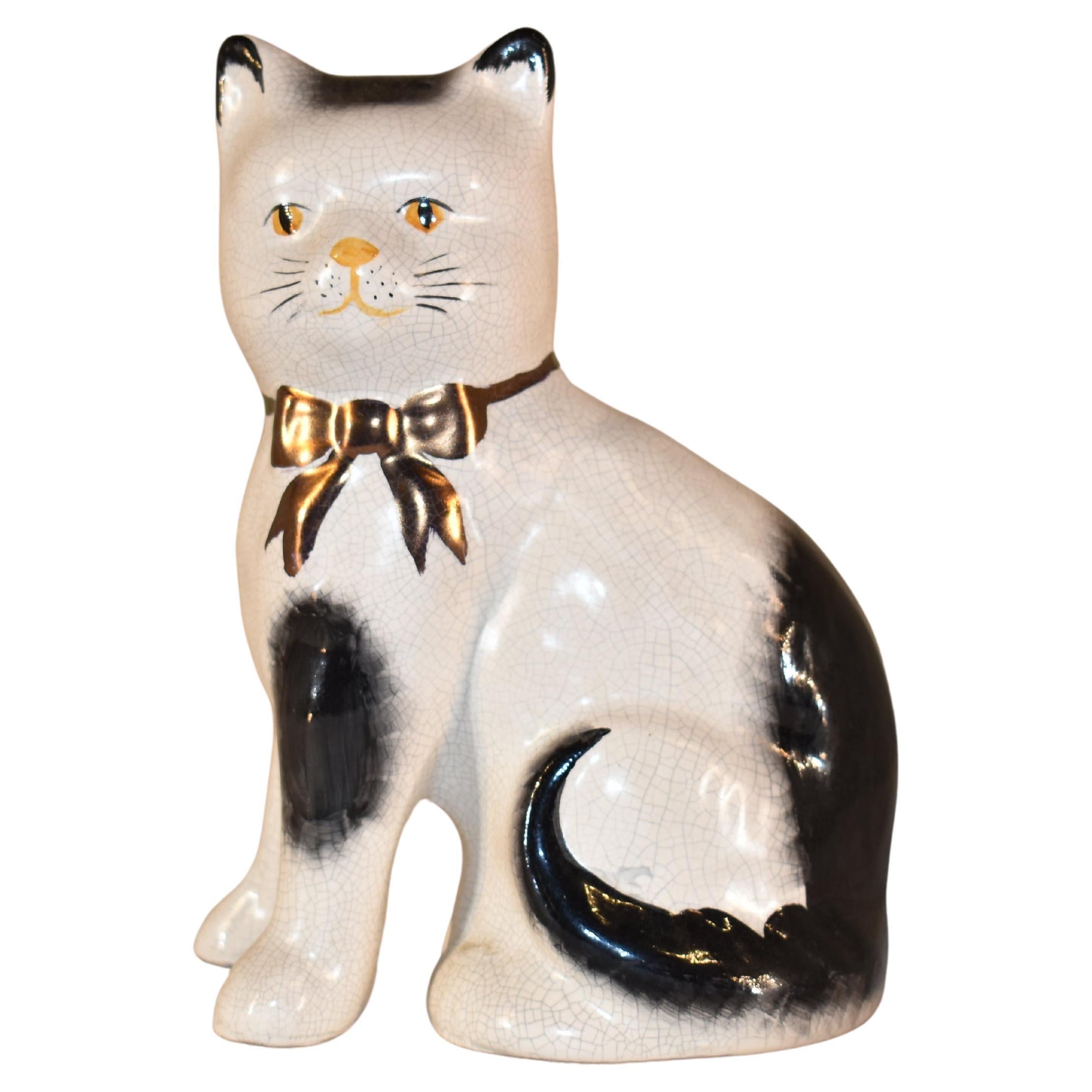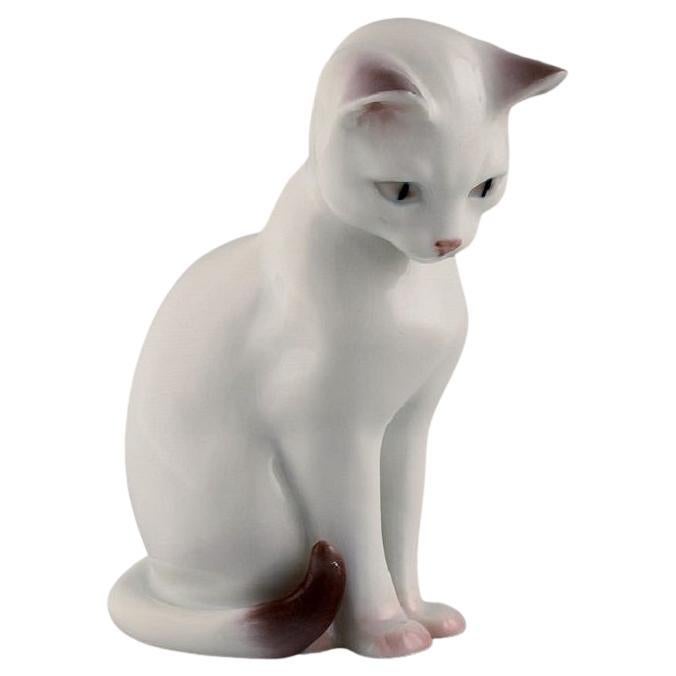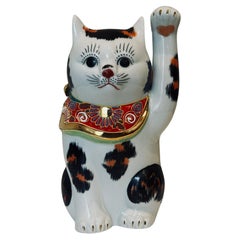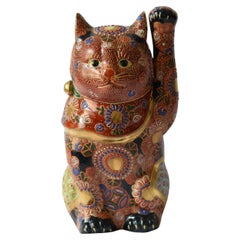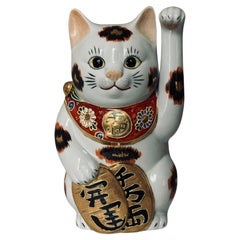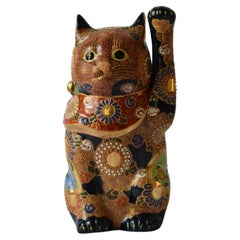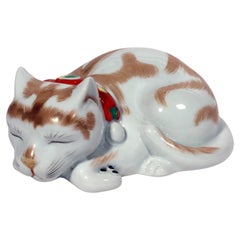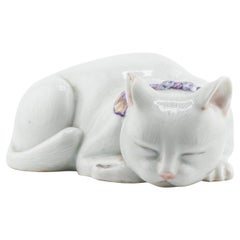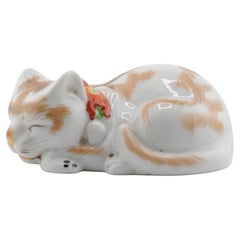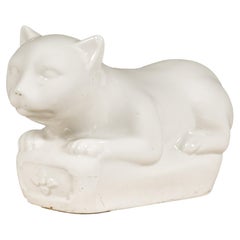Items Similar to Japanese Meiji Period Gold White Porcelain Sleeping Cat Sculpture, circa 1910
Want more images or videos?
Request additional images or videos from the seller
1 of 6
Japanese Meiji Period Gold White Porcelain Sleeping Cat Sculpture, circa 1910
$850
£644.42
€742.84
CA$1,197.09
A$1,327.48
CHF 697.49
MX$16,219.58
NOK 8,726.60
SEK 8,191.40
DKK 5,545.46
About the Item
Exquisite Meiji period Japanese Kutani sculpture of a sleeping cat in fine porcelain, inspired by the small wooden sculpture at the entrance of Toshougu shrine in Nikko, Japan, by the highly acclaimed sculpture artist and architect Hidari Jingoro. The wooden sculpture is recognized as a national treasure. It is called nemuri neko , meaning sleeping cat or peaceful cat, representing a kind of peace that allows a cat to have an ease of mind to sleep with its guards off.
This sleeping cat in pure white is decorated with patterns in gold and has a scarf around her neck in red, yellow and green, with a bell attached.
This charming sleeping cat is in excellent condition.
It comes in a custom-made fancy box.
Dimensions: W 4 in D 3 in H 2 in.
- Dimensions:Height: 2 in (5.08 cm)Width: 4 in (10.16 cm)Depth: 3 in (7.62 cm)
- Style:Meiji (Of the Period)
- Materials and Techniques:
- Place of Origin:
- Period:
- Date of Manufacture:Contemporary
- Condition:Wear consistent with age and use. This sleeping cat is in perfect condition. There are no cracks, chips or repairs.
- Seller Location:Takarazuka, JP
- Reference Number:Seller: CVSD1stDibs: LU2771324254772
About the Seller
5.0
Vetted Professional Seller
Every seller passes strict standards for authenticity and reliability
Established in 2009
1stDibs seller since 2017
231 sales on 1stDibs
- ShippingRetrieving quote...Shipping from: Takarazuka, Japan
- Return Policy
Authenticity Guarantee
In the unlikely event there’s an issue with an item’s authenticity, contact us within 1 year for a full refund. DetailsMoney-Back Guarantee
If your item is not as described, is damaged in transit, or does not arrive, contact us within 7 days for a full refund. Details24-Hour Cancellation
You have a 24-hour grace period in which to reconsider your purchase, with no questions asked.Vetted Professional Sellers
Our world-class sellers must adhere to strict standards for service and quality, maintaining the integrity of our listings.Price-Match Guarantee
If you find that a seller listed the same item for a lower price elsewhere, we’ll match it.Trusted Global Delivery
Our best-in-class carrier network provides specialized shipping options worldwide, including custom delivery.More From This Seller
View AllJapanese Contemporary Gold Orange Black Red Porcelain Beckoning Cat, 2
Located in Takarazuka, JP
Charming beckoning cat with left paw raised is a gilded and hand painted porcelain piece from the Kutani region of Japan.
Beckoning cats come in two varieties. The more common right-handed beckoning cat (with right paw raised) is said to bring money and wealth to its owner, and are to this day frequently seen in shops and restaurants in Japan. The less common left-handed cat is said to be inviting friends and acquaintances to hearth and home.
While the origins of the Japanese beckoning cat (known as maneki neko in Japanese) are unclear, contemporary woodblock...
Category
21st Century and Contemporary Japanese Meiji Animal Sculptures
Materials
Gold
Japanese Contemporary Gold Orange Blue Green Porcelain Lucky Cat Sculpture
Located in Takarazuka, JP
Japanese Contemporary porcelain beckoning cat, a uniquely and intricately gilded and hand painted porcelain piece from the Kutani region of Japan. The cat raising his left paw is adorned with multiple golden medallions and is covered with raised loops characteristic of the Kutani “mori” style. While the origins of the Japanese beckoning cat are unclear, contemporary woodblock...
Category
21st Century and Contemporary Japanese Meiji Animal Sculptures
Materials
Gold
Japanese Contemporary Gold Orange Black Red Hand painted Porcelain Beckoning Cat
Located in Takarazuka, JP
Charming beckoning cat with left paw raised is a gilded and hand painted porcelain piece from the Kutani region of Japan.
The beckoning cat comes in two varieties. The more common right-handed beckoning cat (with right paw raised) is said to bring money and wealth to its owner, and are to this day frequently seen in shops and restaurants in Japan. The less common left-handed cat is said to be inviting friends and acquaintances to hearth and home.
While the origins of the Japanese beckoning cat (known as maneki neko (in Japanese) are unclear, contemporary woodblock...
Category
21st Century and Contemporary Japanese Meiji Animal Sculptures
Materials
Gold
Japanese Contemporary Red Blue Green Gold Porcelain Lucky Cat Sculpture, 2
Located in Takarazuka, JP
Exquisite Japanese Contemporary porcelain beckoning cat, a uniquely and intricately gilded and hand painted porcelain sculpture from the Kutani region of Japan. The cat raising his left paw is adorned with multiple golden medallions and is covered with raised loops characteristic of the Kutani “mori” style. While the origins of the Japanese beckoning cat are unclear, contemporary woodblock prints show they were being widely sold as good luck charms by the 1850s. The beckoning cat comes in two varieties. The more common right-handed beckoning cat (with right paw raised) is said to bring money and wealth to its owner, and are to this day frequently seen in shops and restaurants in Japan. The less common left-handed cat is said to be inviting friends and acquaintances to hearth and home.
The “mori” style refers to raised loops and other decorative motifs applied by squeezing a tube of slip onto the body of the cat much like applying frosting to a cake.
The cat boasts the traditional Kutani colors of bright green, red and yellow presented against an dark blue background, and is generously accentuated with gold. The red kerchief with a knotted amulet in the back and two bells on the side also identify this as a traditional Kutani piece, as do the perked ears turned outward.
A stamp indicating it is produced in Kutani region of Japan appears at reverse side of this beckoning cat scultures...
Category
21st Century and Contemporary Japanese Meiji Animal Sculptures
Materials
Gold
Platinum Gilt Porcelain Vase by Japanese Master Artist
Located in Takarazuka, JP
Exquisite contemporary large dimpled platinum-gilded porcelain vase, an exceptional piece crafted, hand painted and signed by a widely acclaimed master porcelain artist of Japan’s Im...
Category
21st Century and Contemporary Japanese Vases
Materials
Platinum
Japanese Contemporary Ko-Imari Gold Blue Porcelain Koro Incense Burner
Located in Takarazuka, JP
Stunning contemporary Japanese Ko-Imari style porcelain koro or incense burner or jewelry box, hand painted on a beautifully shaped round body in cobalt blue, red and green and gener...
Category
21st Century and Contemporary Japanese Meiji Jewelry Boxes
Materials
Gold
You May Also Like
Japanese Kutani Porcelain Figure of a Sleeping Cat
By Kutani Studio
Located in Downingtown, PA
Japanese Kutani Porcelain Sleeping Cat Figure,
Meiji Period,
Circa 1910-20
The porcelain model of a cat depicts a cat naturalistically modeled with its paws beneath it and it tail f...
Category
Early 20th Century Japanese Meiji Animal Sculptures
Materials
Porcelain
Antique Meiji Kutani Model of a Recumbent Sleeping Cat Sculpture, 19th Century
Located in Amsterdam, Noord Holland
Sharing with you this amazing Japanese Kutani model of a recumbent sleeping cat, 19th Century. The details and facial expression are amazing. With enamel ribbon bow tied around its n...
Category
Antique 19th Century Japanese Meiji Animal Sculptures
Materials
Porcelain
$3,345 Sale Price
20% Off
Antique Meiji Kutani model of a recumbent sleeping cat, 19th Century
Located in Amsterdam, Noord Holland
Sharing with you this amazing Japanese Kutani model of a recumbent sleeping cat, 19th Century. The details and facial expression are amazing. With with gilt fur detail and enamel rib...
Category
Antique 19th Century Japanese Meiji Paintings and Screens
Materials
Porcelain
$2,146 Sale Price
20% Off
Petite Blanc de Chine Porcelain Cat Sculpture, Vintage
Located in Yonkers, NY
This petite vintage Blanc de Chine porcelain cat is a charming and elegant decorative piece that captures the serene beauty of a cat in repose. Crafted with meticulous attention to d...
Category
Mid-20th Century Animal Sculptures
Materials
Porcelain
Staffordshire Cat Figure, Circa 1970
Located in High Point, NC
Circa 1970 vintage figure of a cat from the Staffordshire region of England. The cat is decorated in black and white, and has a gold bow around its neck. This is a nice model, as i...
Category
Vintage 1970s English Animal Sculptures
Materials
Ceramic
B & G / Bing & Grondahl Porcelain Figure, Sitting Cat, Number 2476
Located in København, Copenhagen
B & G / Bing & Grondahl porcelain figure. Sitting cat. Number 2476.
Measures: 13 cm x 11,5 cm
In perfect condition. 1st. factory quality.
Category
20th Century Danish Animal Sculptures
Materials
Porcelain
More Ways To Browse
Sleeping Sculpture
White Porcelain Animal
Gold Cat Sculpture
Japanese Meiji Period Box
Antique Porcelain Bells
Japanese Living Treasure
Japanese Cat
Japanese Porcelain Animals
Sleeping Cat
Antique Call Bell
Japan Bell
Antique Porcelain Cats
Porcelain Cat Sculpture
Japanese White Porcelain Sculptures
Kutani Gold
Wooden Cat Sculpture
Porcelain White Cat
Japanese Kutani Early 20th Century
